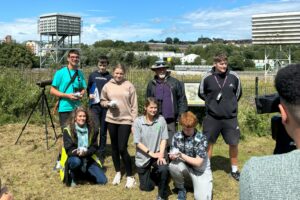KITTIWAKES SEEN NESTING AT ARTIFICIAL NESTS IN NEW KITTIWAKERY IN GATESHEAD

Environmental and community charity, Groundwork NE & Cumbria is celebrating success after reports of kittiwakes seen nesting on artificial nests in the newly constructed KITTIWAKERY, kittiwake tower in Gateshead.
Groundwork has supported Shoney Wind, a renewable energy consultancy with its new artificial kittiwake tower installed on the river Tyne at Gateshead. The team has made artificial kittiwake nests out of natural materials and 3D-printed decoy birds for installation in the tower to attract kittiwakes as they return to the Tyne. Kittiwakes are a type of gull which usually nest on remote coastal cliff ledges. Since the 1960s many have nested on buildings and structures on the Tyne, an easy stop-off point on their route to the sea, where they feed and spend the winter, returning to land to nest between February and August.
Kittiwakes are at risk of global extinction and Newcastle and Gateshead has the largest inland nesting site for kittiwakes in the world. The project aims to determine the best towers for nesting sites forthe gulls.
Last year FLI Structures constructed “The Kittiwakery’ on the south bank of the Tyne in Gateshead. The tower was bespoke, with designs tailored by Shoney Wind to its exact location, taking account of specific environmental conditionsin the North East. The aim was to create the optimum nesting micro-climate for the birds and their chicks. The Kittiwakery was orientated to protect the young birds from the harsh North East winds and to minimise solar glare. Constructed in steel, it was the first in the UK to have an internally accessible staircase which will make monitoring and ringing the birds easier, safer and less disruptive for the birds.
The design is modular and adaptable, with a tower with shelves and individual nesting bays/boxes open at the back for ease of access for monitoring which can be tailored further in future.
Some of the artificial nests were installed when the tower was built in 2023 to encourage the birds to use the tower and there has been some evidence of kittiwake use but no nesting until this month when a pair of kittiwakes was spotted making their home in the tower. Kittiwakes are thought to be site-faithful and do not move easily or relocate once they have chosen a nesting site. The team are delighted with the recent discovery.
Working on the banks of the Don, a tributary of the Tyne, the Groundwork team used mud, seaweed, algae, dry grasses and other nesting materials to make a batch of kittiwake nests. The fake nests are a little bigger than a side plate, fashioned into bowls, packed with mud, and must be kept moist for installation. Pupils from Percy Hedley SEND school in Forest Hall, North Tyneside helped to build this first batch of nests.
Shoney Wind commissioned 3D-printed decoy adult-sized birds to putinto some of the nests and will be working with local schoolchildren over the coming weeks to create decoy downy chicks, made out of clay and feathers and painted to look like real chicks. Hellen Hornby, Project Manager and environmentalist at Groundwork NE & Cumbria explained:
“We are delighted to be working with Shoney Wind on this crucial project to attract kittiwakes to the new breeding ground. We are over the moon to learn that our efforts have been successful and a nesting pair of kittiwakes have taken up residence in the new Kittiwakery.”
“One of the great things about this project is its educational dimension. We’ve worked with local schools and the children have helped make the nests and the decoy chicks getting hands-on, practical experience in how to support local wildlife. We’ve been able to explain about kittiwakes and the importance of protecting endangered species and the environment. As well as making the chicks and helping with the nests, we will take the children bird-watching near the site with binoculars so they can see how their efforts have helped these amazing creatures and the impact on the river Tyne and its wildlife.”
The onshore Kittiwake artificial nesting structure is a pilot project funded by the developing DBS (Dogger Bank South) offshore wind farms and managed by Shoney Wind. Colin McAllister, Development Project Manager for DBS offshore wind farms explained: “The pilot nesting tower is in place to attract young birds to this bespoke environment. We will monitor how many kittiwakes use the tower and how many chicks are raised over time. This data will provide valuable insight to help support kittiwake populations local to renewable energy projects in the future.”
Nathalie Stevenson, Director of Shoney Wind stated “After 4.5 years of intensive research and development we have taken Kittiwakery from a concept to reality. We are delighted that kittiwake are nest-building on Kittiwakery in the 2024 breeding season. We will monitor whether these kittiwake lay eggs this late in the season. Even if the pairs do not breed this year, this bodes well for 2025 where we hope to see many pairs successfully breeding on the tower”
